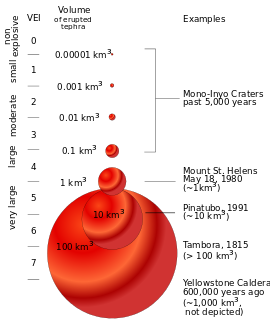
Back Vulkaaneksplosiwiteitsindeks Afrikaans مؤشر التفجر البركاني Arabic Магнітуда вулканічнага вывяржэння Byelorussian Вулканичен експлозивен индекс Bulgarian Índex d'explosivitat volcànica Catalan Index vulkanické aktivity Czech VEI-skalaen Danish Vulkanexplosivitätsindex German Δείκτης Ηφαιστειακής Εκρηκτικότητας Greek Vulkan-eksploda indikilo Esperanto

The volcanic explosivity index (VEI) is a scale used to measure the size of explosive volcanic eruptions. It was devised by Christopher G. Newhall of the United States Geological Survey and Stephen Self in 1982.
Volume of products, eruption cloud height, and qualitative observations (using terms ranging from "gentle" to "mega-colossal") are used to determine the explosivity value. The scale is open-ended with the largest eruptions in history given a magnitude of 8. A value of 0 is given for non-explosive eruptions, defined as less than 10,000 m3 (350,000 cu ft) of tephra ejected; and 8 representing a supervolcanic eruption that can eject 1.0×1012 m3 (240 cubic miles) of tephra and have a cloud column height of over 20 km (66,000 ft). The scale is logarithmic, with each interval on the scale representing a tenfold increase in observed ejecta criteria, with the exception of between VEI-0, VEI-1 and VEI-2.[1]
- ^ Newhall, Christopher G.; Self, Stephen (1982). "The Volcanic Explosivity Index (VEI): An Estimate of Explosive Magnitude for Historical Volcanism" (PDF). Journal of Geophysical Research. 87 (C2): 1231–1238. Bibcode:1982JGR....87.1231N. doi:10.1029/JC087iC02p01231. Archived from the original (PDF) on December 13, 2013.